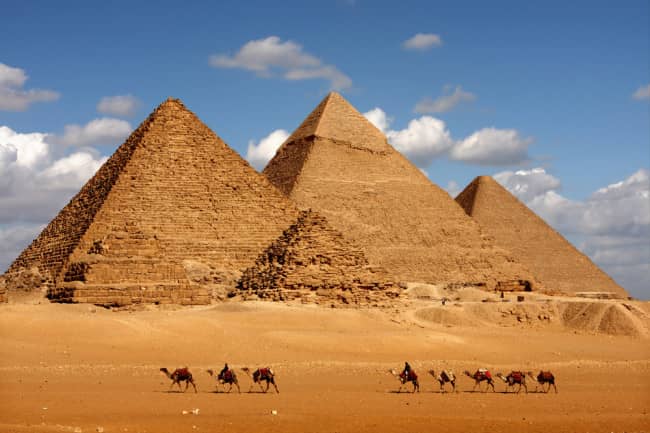There’s no end to conspiracy theories about who built the pyramids. Frequently they involve ancient aliens, lizard people, the Freemasons, or an advanced civilization that used forgotten technology. Scientists have tried and failed to combat these baseless ideas. But there is another misconception about pyramid construction that’s plagued Egyptian scholars for centuries: Slaves did not build the pyramids.
The best evidence suggests that pyramid workers were locals who were paid for their services and ate extremely well. We know this because archaeologists have found their tombs and other signs of the lives they lived.
The Lives of Pyramid Workers
In 1990, a number of humble gravesites for pyramid workers were found a surprisingly short distance from the tombs of the pharaohs. Inside, archaeologists discovered all the necessary goods that pyramid workers would need to navigate passage to the afterlife — basic kindnesses unlikely to have been afforded common slaves.
But that’s not all. Archaeologists have also spent years excavating a sprawling complex thought to have been a part-time home for thousands of workers. The site is called Heit el-Ghurab, and it was also likely part of a larger port city along the Nile River where food and supplies for the pyramid workers, as well as pyramid construction materials, were imported from across the region. Inside the rubble of Heit el-Ghurab, they found evidence for large barracks where as many as 1,600 or more workers could have slept together. And archaeologists also uncovered extensive remains from the many meals they ate, including abundant bread and huge quantities of meat, like cattle, goat, sheep and fish.
These workers’ graffiti can also be found all over the buildings they created. The marks, written in Egyptian, were hidden on blocks inside the pyramids and were never meant to be seen. They record the names of various work gangs, including “the Drunkards of Menkaure” and “the Followers of the Powerful White Crown of Khufu.” (Both gangs were named after the respective pharaohs of their day.) Other marks signify towns and regions in Egypt. A few seem to function as mascots that represent a division of workers, and they feature images of animals such as ibises.
Together, these hieroglyphics give archaeologists hints about where the workers came from, what their lives were like, and who they worked for. Nowhere have archaeologists found signs of slavery or foreign workers. Meanwhile, there is ample evidence of labor tax collection throughout ancient Egypt. That’s led some researchers to suggest workers might have rotated through tours of construction, like a form of national service. However, it’s also unclear if that means the workers were coerced.
Hollywood Myths of Egypt
So why do so many people think the Egyptian pyramids were built by slaves? The Greek historian Herodotus seems to have been the first to suggest that was the case. Herodotus has sometimes been called the “father of history.” Other times he’s been dubbed the “father of lies.” He claimed to have toured Egypt and wrote that the pyramids were built by slaves. But Herodotus actually lived thousands of years after the fact.
Another obvious origin of the slave idea comes from the longstanding Judeo-Christian narrative that the Jews were enslaved in Egypt, as conveyed by the story of Moses in the book of Exodus.
Hollywood took the idea and ran with it. Cecil B. DeMille’s The Ten Commandments films — originally released in 1923 and then reshot in 1956 — depicted a tale of the Israelites enslaved and forced to construct great buildings for the pharaohs. And as recently as 2014, the Ridley Scott movie Exodus: Gods and Kings depicted Christian Bale as Moses freeing the Jews from slavery as they built the pyramids. Egypt banned the film, citing “historical inaccuracies,” and its people have repeatedly spoken out against Hollywood movies that repeat Biblical narratives about Jewish people building Egyptian cities. Even the 1998 Dreamworks animated film, The Prince of Egypt, earned significant criticism for its depictions of Moses and Jewish slaves forced into construction projects.
In fact, archaeologists have never found evidence for the Biblical tales that the Israeli people were imprisoned in Egypt. And even if the Jewish people were imprisoned in Egypt, it’s extremely unlikely that they would have built the pyramids. The last pyramid, the so-called Pyramid of Ahmose, was built roughly 3,500 years ago. That’s hundreds of years before historians think the Israeli people first appeared. It’s also centuries before the oldest known Egyptian reference to the Jews on the Victory Stele of Merneptah.
So, while archaeologists still have much to learn about the people who built the pyramids and how the work was organized and executed, it is easy to throw out this basic misconception. The pyramids were built by Egyptians.


